Acids
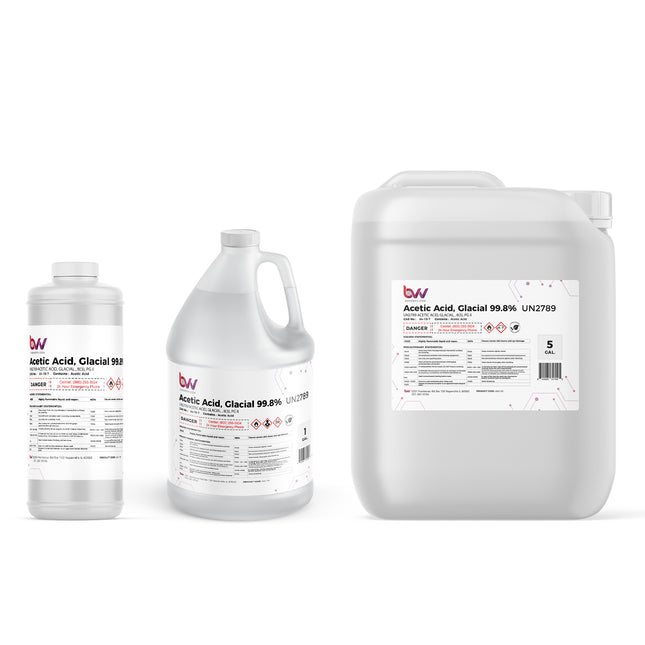
Glacial Acetic Acid 99.8% Food Grade
BVV™ Food Grade Glacial Acetic Acid 99.8% pH: 2.4 Looking for a food-grade acid for your acid-base extraction? Our premium Glacial Acetic Acid is precisely what you need! As a leading supplier of high-purity solvents & chemicals, we provide the purest Glacial Acetic Acid available for your acid-base extraction and pH adjustment needs, ensuring exceptional results every time. Acetic acid, also known as ethanoic acid, is a versatile organic compound that plays a significant role in various industries and everyday life. It is a colorless liquid with a pungent, vinegar-like odor. Acetic acid (CH3COOH) is a weak acid that is highly soluble in water and many organic solvents. Due to its unique properties, acetic acid is widely used as a solvent, preservative, and flavoring agent in the food and beverage industry. It is also a key component in the production of vinyl acetate, which is used in the manufacturing of adhesives, coatings, and textiles. Furthermore, acetic acid is utilized in the synthesis of numerous chemicals, including pharmaceuticals, dyes, and plastics. Its diverse range of applications makes acetic acid an essential compound in many industrial processes, where it contributes to the creation of countless products that we encounter in our daily lives. Glacial Acetic Acid, also known as ethanoic acid, is a highly concentrated and pure form of acetic acid. Its name, "glacial," refers to its ability to freeze at a relatively low temperature (16.6C/61.9F). This characteristic sets it apart from other forms of acetic acid, making it ideal for various industrial applications, including acid-base extraction. Our Glacial Acetic Acid contains less than 1% water and is also considered water-free anhydrous acetic acid. In acid-base extraction, Glacial Acetic Acid serves as an essential component due to its unique properties. It acts as a weak acid, enabling the extraction of alkaline compounds from organic mixtures. With our premium Glacial Acetic Acid, you can achieve efficient separation of target compounds by adjusting the pH and facilitating the formation of soluble salts. In addition to its use in acid-base extraction, our Glacial Acetic Acid finds widespread application in various industries, including pharmaceuticals, textiles, and food processing. It is also known for its ability to dissolve and remove mineral deposits, making it an excellent choice for descaling and cleaning applications. At BVV, we take pride in delivering premium solvents, chemicals, and adsorbents that exceed customer expectations. Our team of experts is always available to provide personalized support and guidance, ensuring that you find the right solution for your needs. With our high-purity Glacial Acetic Acid & Sodium Hydroxide, you can optimize your acid-base extraction processes and pH adjustment needs to achieve exceptional results. Ready to elevate your acid-base extraction procedures? Order our High Purity Glacial Acetic Acid & Sodium Hydroxide today and experience its superior quality and performance firsthand. Contact us now to learn more and take advantage of our competitive prices and prompt delivery. Unlock the potential of your acid-base extractions with BVV! Chemical Formula: CH3COOH Molecular Weight: 60.052 g·mol−1 CAS Registry Number: 64-19-7 Appearance Colorless, transparent liquid, Odor: Heavily vinegar-like Density 1.049 g/cm3 (liquid); 1.27 g/cm3 (solid) Boiling Point: 16 °C / 61°F GHS Pictograms: GHS Signal Word: Danger GHS Hazard Statements: H226, H314 GHS Precautionary Statements P280, P305+P351+P338, P310 UN Identification Number: 2789 Proper Shipping Name: Acetic Acid, Glacial Transport Hazard Class: 8 Packing Group: II DOT Placard: What is Acetic Acid? Acetic acid, also known as ethanoic acid, is a colorless liquid organic compound with a distinct sour taste and pungent smell. It is a member of the carboxylic acid family and is classified as a weak acid due to its partial ionization in aqueous solutions. Acetic acid is a fundamental building block in various chemical reactions and is commonly found in vinegar, giving it its characteristic sour taste. Chemically represented as CH3COOH, acetic acid consists of two main components: a carboxyl group (-COOH) and a methyl group (-CH3). It is produced naturally through fermentation processes, where bacteria convert ethanol into acetic acid. Additionally, acetic acid can be synthesized through various chemical methods for industrial applications. Acetic acid is widely utilized in various industries, including food, pharmaceuticals, textiles, and chemicals. It serves as a crucial ingredient in the production of plastics, solvents, dyes, and synthetic fibers. Its versatile nature makes it an essential component in countless products and processes, contributing to a wide range of applications across different sectors. What Is Acetic Acids Formula? Chemically represented as CH3COOH, acetic acid consists of two main components: a carboxyl group (-COOH) and a methyl group (-CH3). It is produced naturally through fermentation processes, where bacteria convert ethanol into acetic acid. Additionally, acetic acid can be synthesized through various chemical methods for industrial applications. What is Acetic Acids Structure? The structure of acetic acid consists of two carbon atoms (C), four hydrogen atoms (H), and two oxygen atoms (O) arranged in a specific pattern. It forms a molecule with a central carbon atom bonded to two oxygen atoms: one oxygen atom is double-bonded to the carbon (C=O) and the other is bonded via a single bond (C-OH). This arrangement creates a carboxyl group (COOH) at one end of the molecule. The remaining carbon and hydrogen atoms are bonded in a linear chain, resulting in the overall molecular structure of CH3COOH. What Is Acetic Acids Molar Mass? The molar mass of a chemical compound is a measure of the mass of one mole of that substance, expressed in grams per mole (g/mol). For acetic acid (CH3COOH), which is a simple organic compound, the molar mass is calculated by adding up the atomic masses of all the individual atoms in its chemical formula. Let's break down the components of acetic acid: Carbon (C) - Atomic mass: 12.01 g/mol Hydrogen (H) - Atomic mass: 1.01 g/mol (there are 2 hydrogen atoms) Oxygen (O) - Atomic mass: 16.00 g/mol (there are 2 oxygen atoms) Another Oxygen (O) - Atomic mass: 16.00 g/mol Hydrogen (H) - Atomic mass: 1.01 g/mol (there is 1 hydrogen atom) Now, add up the atomic masses: 12.01 g/mol (C) + 1.01 g/mol (H) + 1.01 g/mol (H) + 16.00 g/mol (O) + 16.00 g/mol (O) + 1.01 g/mol (H) = 60.05 g/mol Therefore, the molar mass of acetic acid is approximately 60.05 g/mol. This value is crucial for various chemical calculations and reactions involving acetic acid, including determining quantities in chemical reactions or preparing solutions with specific concentrations. What is the PKA of Acetic Acid? The pKa of acetic acid (CH3COOH) is approximately 4.75. The pKa value represents the acidity of a compound and indicates the strength of its dissociation in aqueous solution. Acetic acid is a weak acid, meaning that it does not completely dissociate into ions in water and has a relatively low tendency to donate protons (H+ ions). Is Acetic Acid A Weak or Strong Acid? Acetic acid (CH3COOH) is considered a weak acid. Weak acids are substances that only partially dissociate into ions when dissolved in water. In the case of acetic acid, it releases a limited number of hydrogen ions (H+) and acetate ions (CH3COO-) in water. This is in contrast to strong acids, which completely dissociate into ions and release a higher concentration of hydrogen ions in solution. What Is The Boiling Point of Acetic Acid? The boiling point of acetic acid is approximately 118.1 degrees Celsius (244.5 degrees Fahrenheit) at standard atmospheric pressure. However, this value can vary slightly depending on factors such as atmospheric pressure and impurities present in the acetic acid. What Is The Density of Acetic Acid? The density of acetic acid is approximately 1.049 grams per cubic centimeter (g/cm³) at 20 degrees Celsius (68 degrees Fahrenheit). Keep in mind that the density of acetic acid can vary slightly with temperature and concentration. What Is Glacial Acetic Acid? Glacial acetic acid, also known as anhydrous acetic acid, is a highly concentrated and pure form of acetic acid. The term "glacial" is used to describe its appearance, as it solidifies into ice-like crystals at room temperature due to its high freezing point. Glacial acetic acid typically has a concentration of around 99-100%, making it one of the purest forms of acetic acid available. This highly concentrated form of acetic acid is commonly used in various industrial, laboratory, and chemical applications. It is often utilized as a solvent, reagent, or catalyst in chemical reactions, as well as in the production of various chemicals, plastics, textiles, and pharmaceuticals. Glacial acetic acid's high purity and reactivity make it a valuable component in many manufacturing processes and scientific experiments. It's important to handle glacial acetic acid with care due to its corrosive and strong acidic properties. Proper safety precautions should be taken when working with this substance, including using appropriate protective equipment and following recommended handling procedures. What Is Acetic Acid Used For? Acetic acid is a versatile chemical compound with a wide range of applications across various industries. Here are some common uses of acetic acid: Food and Beverage Industry: Acetic acid is a key component in the production of vinegar, which is used as a condiment, flavor enhancer, and food preservative. It is also used in the production of pickles, sauces, and dressings. Chemical Industry: Acetic acid is used as a chemical intermediate in the production of various chemicals, including acetate esters, acetic anhydride, and vinyl acetate monomer. These chemicals are used in the manufacturing of plastics, synthetic fibers, dyes, and pharmaceuticals. Cleaning and Disinfecting: Acetic acid is commonly used as an environmentally friendly cleaning agent due to its mild acidity and disinfectant properties. It can effectively remove mineral deposits, stains, and mold from surfaces. Textile Industry: Acetic acid is used in the production of acetate fibers, which are used to make fabrics, textiles, and clothing items. It is also employed in dyeing and finishing processes. Photography: Acetic acid is used in photographic processes, including film development and as a fixing agent for prints. Preservation: Acetic acid is used to preserve and prevent spoilage in various agricultural products, such as fruits and vegetables. Laboratory and Research: Acetic acid is commonly used in laboratories for various purposes, including chemical analysis, pH adjustment, and buffer preparation. Medicine and Pharmaceuticals: Acetic acid is used in the synthesis of pharmaceutical compounds and as a solvent for certain medications and ointments. Wastewater Treatment: Acetic acid is used in wastewater treatment processes to adjust pH levels and promote the growth of beneficial microorganisms. Tanning Industry: Acetic acid is used in leather tanning processes to adjust the pH of the solutions and aid in the removal of unwanted substances. Plastics and Polymers: Acetic acid is a precursor in the production of polyvinyl acetate (PVA) and other polymer materials used in adhesives, coatings, and paints. Oil and Gas Industry: Acetic acid is employed in the oil and gas industry for processes such as well drilling, acidizing, and corrosion inhibition. Electronics Industry: Acetic acid is used for cleaning and etching electronic components and printed circuit boards. These are just a few examples of the diverse applications of acetic acid. Its chemical properties make it a valuable ingredient in numerous industrial and consumer products, contributing to various processes and sectors. What Are The Hazards of Acetic Acid? Acetic acid is generally considered safe when used properly and handled with care. However, like any chemical compound, it can pose certain hazards if not used and managed correctly. Here are some potential hazards associated with acetic acid: Corrosive Nature: Acetic acid is a corrosive substance, and concentrated solutions can cause severe irritation or burns to the skin, eyes, and respiratory tract upon direct contact. Prolonged exposure to the skin or eyes can result in chemical burns and tissue damage. Inhalation Risks: Inhaling acetic acid vapors or mists can irritate the respiratory system, causing symptoms such as coughing, shortness of breath, and throat irritation. Prolonged or intense exposure to vapors can lead to more severe respiratory effects. Fire and Explosion Hazard: Acetic acid is flammable, with a low flashpoint. Concentrated vapors or mists can ignite and potentially cause fires or explosions when exposed to an open flame, spark, or heat source. Incompatibility: Acetic acid may react with certain chemicals and substances, resulting in potentially hazardous reactions or releases of toxic gases. Proper storage and handling procedures are essential to prevent such interactions. Toxicity: Ingesting or consuming concentrated acetic acid can lead to serious health issues, including chemical burns in the digestive tract, internal injuries, and other toxic effects. Ingestion should be avoided. Environmental Impact: Improper disposal or release of acetic acid into the environment can harm aquatic life and ecosystems. It can also contribute to air pollution when released into the atmosphere. Sensitization: Prolonged or repeated exposure to acetic acid can lead to sensitization, where an individual becomes more susceptible to adverse effects upon subsequent exposures. To mitigate these hazards and ensure safe handling of acetic acid, it's important to follow proper safety guidelines and precautions How Do I Use Glacial Acetic Acid Safely? Using glacial acetic acid safely is essential due to its corrosive and strong acidic properties. Follow these guidelines to ensure safe handling and use: Personal Protective Equipment (PPE): Wear appropriate PPE, including chemical-resistant gloves, safety goggles, a lab coat or protective clothing, and closed-toe shoes to prevent contact with the skin, eyes, and clothing. Well-Ventilated Area: Work in a well-ventilated area or use a fume hood to minimize inhalation exposure. Ensure proper ventilation to prevent the buildup of fumes. Avoid Contact: Avoid direct skin contact with glacial acetic acid. In case of accidental skin contact, immediately rinse the affected area with copious amounts of water and seek medical attention if irritation persists. Eye Protection: Wear safety goggles or a face shield to protect your eyes from potential splashes or fumes. In case of eye contact, rinse the eyes thoroughly with water and seek immediate medical assistance. Handling and Pouring: When handling glacial acetic acid, use chemical-resistant containers and utensils. Pour slowly to avoid splashing and minimize the release of fumes. Always use a chemical-resistant funnel for transferring the acid. Dilution: If dilution is required, always add glacial acetic acid to water, never the other way around. Adding water to the acid can cause a violent reaction. Storage: Store glacial acetic acid in a cool, dry, and well-ventilated area, away from direct sunlight and incompatible substances. Ensure proper labeling of containers and keep them tightly sealed to prevent evaporation and fume release. First Aid: Have an eyewash station and safety shower readily accessible in case of accidental exposure. Know the location of emergency exits and procedures. Emergency Response: In case of spills or leaks, contain and absorb the acid using appropriate absorbent materials. Neutralize any spilled acid with a suitable neutralizing agent under proper ventilation. Dispose of contaminated materials as hazardous waste. Training: Ensure that personnel handling glacial acetic acid are trained in its proper handling, storage, and emergency response procedures. Regularly review safety protocols. Medical Attention: If you experience skin contact, eye exposure, or inhalation of fumes, seek medical attention immediately. Provide medical professionals with accurate information about the substance involved. Always refer to the Material Safety Data Sheet (MSDS) or Safety Data Sheet (SDS) provided by the manufacturer for specific safety information and handling guidelines for the glacial acetic acid product you are using. Following proper safety protocols and practices is crucial to prevent accidents and ensure the well-being of individuals working with glacial acetic acid. Acetic Acid Glacial 99.8% Certificate of Analysis (COA) Acetic Acid Glacial 99.8% Safety Data Sheet (SDS)
$20.00 - $3,300.00
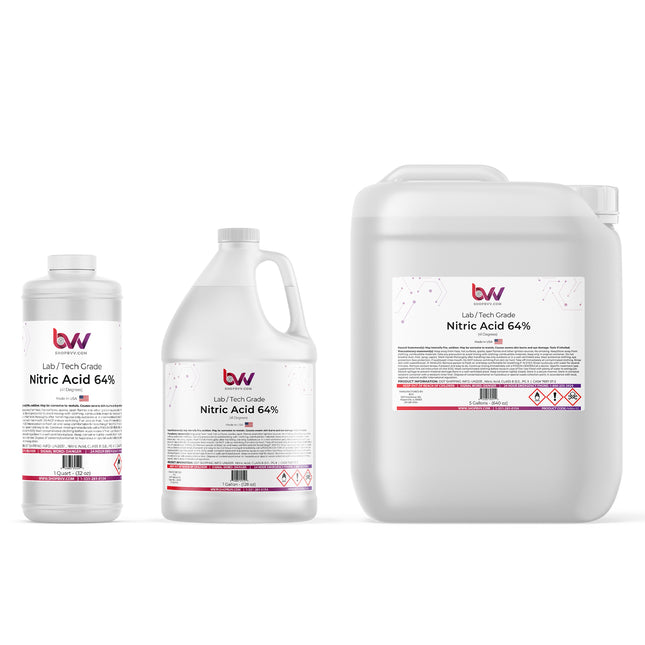
Nitric Acid 64.6% Lab Grade
Nitric Acid 64.6% Laboratory / Technical Grade *Excellent for gold refining Nitric Acid 64.6% (41° Baumé) (HNO3) is a highly corrosive mineral acid widely used in various industrial application. It is a clear to pale yellow in color and is a strong oxidizing agent known for its corrosive properties. It is commonly used in chemical manufacturing, metal processing, and as a laboratory reagent. Nitric Acid plays a key role in refining gold, particularly in methods like aqua regia refining and in parting processes. Urban mining and pcb board gold recovery commonly uses nitric acid to dissolve gold. *Ships in Level 4 Fluorinated Polyethylene Bottles, 55g ships in HDPE blue drum. Aqua Regia Gold Refining Process (Most Common Use)Aqua regia is a mixture of nitric acid (HNO₃) and hydrochloric acid (HCl) in a 1:3 ratio. This combination dissolves gold, which neither acid can do alone. Step-by-step Overview:Preparation of Aqua Regia: Mix 1 part nitric acid with 3 parts hydrochloric acid. Dissolution: Add impure gold to the aqua regia. Nitric acid oxidizes the gold to gold ions (Au³⁺). Hydrochloric acid provides chloride ions (Cl⁻) to form chloroauric acid (HAuCl₄), which is soluble. Filtration: Filter the solution to remove impurities and undissolved metals. Precipitation: Add a reducing agent like sodium metabisulfite (Na₂S₂O₅) to the solution. This causes pure gold to precipitate out of solution as fine particles. Washing & Melting: Wash the gold powder, dry it, and melt it to form pure gold bars or granules. Chemical Formula: HNO3 Molecular Weight: 63.013 CAS Registry Number: 7697-37-2 Appearance Colorless to faint yellow Odor: Acrid Density > 1.4078@ 25 °C Boiling Point: 248 'F 67.2% HNO3 Solubility in water: Completely Soluble GHS Pictograms: GHS Signal Word: Danger GHS Hazard Statements: H272, H314, H330 GHS Precautionary Statements P210, P220, P260, P264, P271, P280, P284, P301+P330+P331, P302+P361+P354, P304+P340, P305+P354+P338, P316, P320, P321, P363, P370+P378, P403+P233, P405, and P501 UN Identification Number: 2031 Proper Shipping Name: Nitric Acid Transport Hazard Class: 5.1, 8 Packing Group: II DOT Placard: Nitric Acid 64% Lab/Tech Grade Safety Data Sheet (SDS) Nitric Acid 64% Lab/Tech Grade Certificate of Analysis (COA)
$28.00 - $850.00
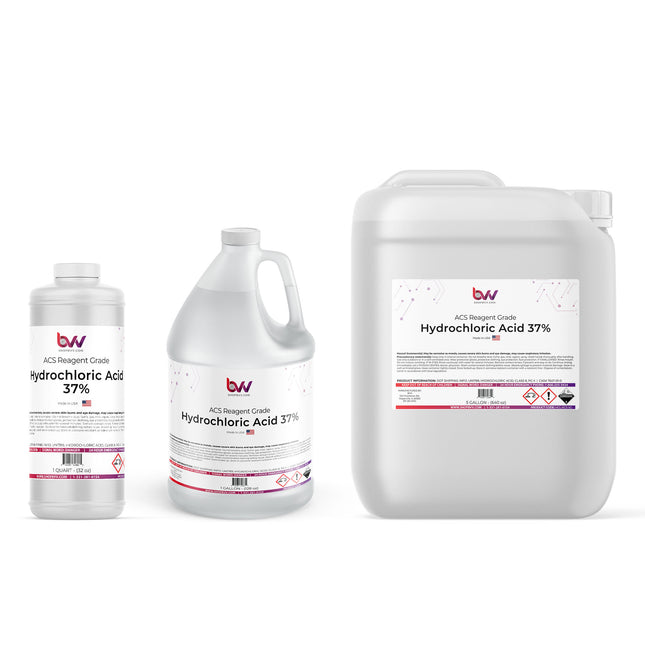
Hydrochloric Acid 37% ACS Reagent Grade (HCL)
Hydrochloric Acid 37% ACS Reagent Grade HCL pH: 1.1 Hydrochloric acid, solution is a colorless watery liquid with a sharp, irritating odor. Consists of hydrogen chloride, a gas, dissolved in water. Sinks and mixes with water. HCL vapors are heavier than air. It is classified as a Strong Acid and is used in many types of laboratory preparations. Cruelty-free: Our Hydrochloric Acid is not tested on animals. Chemical Formula: HCl Molecular Weight: 36.46 CAS Registry Number: 7647-01-0 Appearance Colorless, transparent liquid, fumes in air if concentrated Odor: Pungent characteristic Density 0.81 g/cm3 Boiling Point: 61C @ 36% Concentration GHS Pictograms: GHS Signal Word: Danger GHS Hazard Statements: H290, H314, H335 GHS Precautionary Statements P210, P233, P240, P305+P351+P338, P403+P23 P260, P280, P303+P361+P353, P305+P351+P338 UN Identification Number: 1789 Proper Shipping Name: Hydrochloric acid solution Transport Hazard Class: 8 Packing Group: II DOT Placard: What Is Hydrochloric Acid? Hydrochloric acid (HCl) is a strong, highly corrosive acid that is widely used in various industrial, commercial, and laboratory applications. It is a solution of hydrogen chloride gas dissolved in water, forming a clear, colorless liquid with a sharp, pungent odor. Chemically, hydrochloric acid is composed of hydrogen (H) and chlorine (Cl) atoms, with a chemical formula of HCl. In aqueous solution, hydrochloric acid dissociates into hydrogen ions (H⁺) and chloride ions (Cl⁻), making it a strong acid. How Is Hydrochloric Acid Produced? Hydrochloric acid (HCl) is typically produced on an industrial scale through the chemical reaction between hydrogen gas (H2) and chlorine gas (Cl2). This reaction is exothermic and requires the presence of a suitable catalyst to proceed efficiently. The primary method for producing hydrochloric acid involves the following steps: Preparation of Hydrogen: Hydrogen gas (H2) is produced through various methods, such as steam reforming of natural gas (methane), electrolysis of water, or as a byproduct of certain chemical processes. Steam reforming is the most common method for large-scale hydrogen production, where methane is reacted with steam in the presence of a nickel-based catalyst to produce hydrogen gas and carbon monoxide: CH4 + H2O → CO + 3H2 The produced hydrogen gas is then purified to remove impurities before use in the hydrochloric acid production process. Preparation of Chlorine: Chlorine gas (Cl2) is typically produced by the electrolysis of sodium chloride (table salt) solution, known as the chlor-alkali process. In this process, an electric current is passed through a brine solution (sodium chloride dissolved in water), resulting in the decomposition of water and the formation of chlorine gas at the anode: 2Cl⁻ → Cl2 + 2e⁻ The chlorine gas is then purified and dried to remove any water vapor before use in the hydrochloric acid production process. Hydrogen-Chlorine Reaction: Once hydrogen and chlorine gases are prepared, they are combined and reacted in a controlled manner. The reaction typically occurs in a reactor vessel equipped with a suitable catalyst, such as platinum or rhodium, to facilitate the reaction: H2 + Cl2 → 2HCl This reaction produces hydrochloric acid gas (HCl), which is then cooled and condensed to form a liquid solution of hydrochloric acid. Dissolution in Water: The hydrochloric acid gas is dissolved in water to produce a concentrated solution of hydrochloric acid. This solution can be further diluted to the desired concentration for various industrial, commercial, or laboratory applications. Overall, the production of hydrochloric acid involves the controlled reaction of hydrogen and chlorine gases in the presence of a catalyst, followed by the dissolution of the resulting hydrochloric acid gas in water. The process is typically carried out in specialized chemical plants equipped with the necessary infrastructure and safety measures to handle corrosive and hazardous materials. What Is Hydrochloric Acid Used for? Hydrochloric acid (HCl) is a versatile and widely used chemical with numerous industrial, commercial, and laboratory applications. Some common uses of hydrochloric acid include: Chemical Manufacturing: Hydrochloric acid is used in the production of a wide range of chemicals, including chlorine, vinyl chloride (used to make PVC), and various pharmaceuticals, dyes, and pigments. Steel Pickling: Hydrochloric acid is commonly used for pickling or cleaning steel surfaces to remove rust, scale, and other impurities before further processing, such as galvanizing or coating. pH Control: Hydrochloric acid is used as a pH adjuster or neutralizer in various industrial processes, wastewater treatment, and swimming pool maintenance. Food Processing: Hydrochloric acid is used in the food industry for various purposes, including adjusting acidity, flavor enhancement, and food preservation (in accordance with regulatory guidelines). Laboratory Applications: Hydrochloric acid is commonly used in laboratories for chemical analysis, titrations, and as a reagent in various chemical reactions. Household Cleaning Products: Dilute hydrochloric acid solutions are used in household cleaning products, such as toilet bowl cleaners and descaling agents. Oil and Gas Production: Hydrochloric acid is used in the oil and gas industry for various applications, including well acidization to enhance the productivity of oil and gas wells. Water Treatment: Hydrochloric acid is used in water treatment processes to control pH, remove mineral scale deposits, and neutralize alkaline substances. Textile and Leather Processing: Hydrochloric acid is used in textile and leather processing industries for desizing, bleaching, and pH adjustment. Metal Cleaning and Etching: Hydrochloric acid is used for cleaning and etching metals, such as aluminum, copper, and brass, in various manufacturing processes. Chemical Synthesis: Hydrochloric acid is used as a reactant or catalyst in various chemical synthesis processes, including the production of pharmaceuticals, plastics, and synthetic rubber. These are just a few examples of the diverse range of applications for hydrochloric acid. Its versatility, corrosive properties, and ability to adjust pH make it an essential chemical in many industries and processes. However, it's important to handle hydrochloric acid with care due to its corrosive nature and potential health hazards. Proper safety precautions, such as wearing protective equipment and following appropriate handling and storage procedures, should be observed when working with hydrochloric acid. What Are The Hazards of Hydrochloric Acid? Hydrochloric acid (HCl) is a highly corrosive and hazardous chemical that can pose several risks to human health, safety, and the environment. Some of the main hazards associated with hydrochloric acid include: Corrosive Properties: Hydrochloric acid is highly corrosive to skin, eyes, respiratory tract, and mucous membranes. Contact with concentrated hydrochloric acid can cause severe chemical burns, irritation, and tissue damage. Inhalation of hydrochloric acid vapors or mists can also cause irritation and damage to the respiratory system. Acute Toxicity: Exposure to high concentrations of hydrochloric acid vapor or mist can cause acute toxicity, leading to symptoms such as coughing, difficulty breathing, chest pain, and throat irritation. Severe exposure may result in pulmonary edema (fluid buildup in the lungs) and respiratory distress. Environmental Hazards: Spills or releases of hydrochloric acid can have adverse effects on the environment, including contamination of soil, water bodies, and aquatic ecosystems. Hydrochloric acid can be corrosive to metals and may cause damage to infrastructure and equipment if not properly contained and managed. Reactivity: Hydrochloric acid is reactive with a wide range of substances, including metals, alkalis, and organic materials. It can release hazardous gases (such as hydrogen gas) when reacting with certain metals, posing fire and explosion hazards in confined spaces. Storage and Handling Risks: Hydrochloric acid must be stored and handled with care due to its corrosive and reactive nature. Improper storage, handling, or mixing with incompatible substances can lead to accidents, spills, and exposure incidents. Health Effects: Prolonged or repeated exposure to hydrochloric acid vapor or mist may cause chronic respiratory effects, such as bronchitis, asthma, or chronic obstructive pulmonary disease (COPD). Individuals with pre-existing respiratory conditions or sensitivities may be more susceptible to the effects of hydrochloric acid exposure. Skin and Eye Damage: Contact with hydrochloric acid can cause severe chemical burns and damage to the skin and eyes. Eye contact may result in irritation, redness, and blurred vision, while skin contact may cause pain, redness, and blistering. Ingestion Hazards: Ingestion of hydrochloric acid can cause severe burns to the mouth, throat, esophagus, and stomach, leading to tissue damage, perforation, and internal bleeding. Ingestion of even small amounts of concentrated hydrochloric acid can be life-threatening and requires immediate medical attention. Overall, the hazards associated with hydrochloric acid underscore the importance of proper handling, storage, and use of this chemical in industrial, commercial, and laboratory settings. Employers and workers should be trained on the safe handling procedures, use of personal protective equipment, and emergency response protocols to minimize the risks associated with hydrochloric acid exposure. Additionally, regulatory guidelines and safety standards should be followed to ensure compliance and protect human health and the environment. Hydrochloric Acid Safety Data Sheet (SDS)
$16.00 - $1,150.00
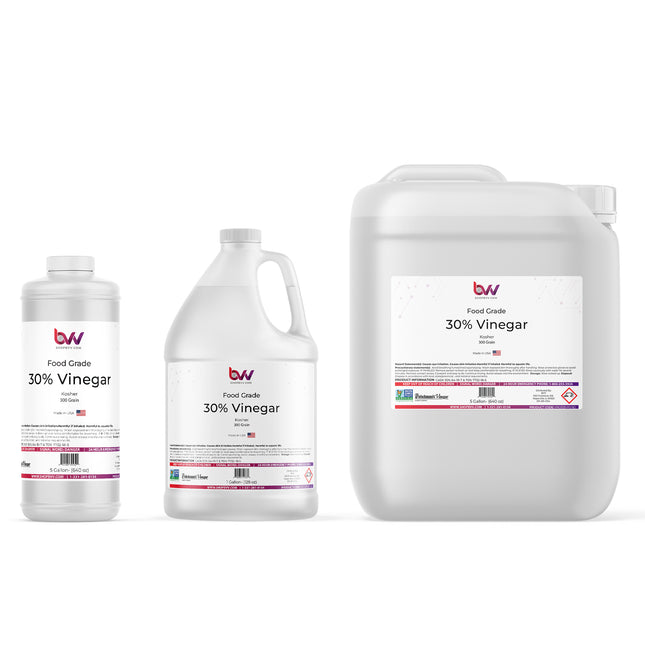
30% Food Grade Distilled White Vinegar (Acetic Acid) - Non GMO
30% Distilled White Vinegar Food Grade - Kosher - Non GMO This is 300 grain White Distilled Vinegar. This vinegar is the result of the natural acetous fermentation of dilute ethyl alcohol from agricultural origin. The alcohol is converted to acetic acid by the microorganism Acetobacter aceti in vinegar generators or acetators. The product is prepared in accordance with the best commercial practice under strict sanitary conditions and the Federal guidelines for Good Manufacturing Practices. It is free of clarifiers, preservatives or other impurities and is Kosher certified. Ships in HDPE FDA Compliant Bottles. Chemical Formula: CH3COOH Molecular Weight: 60.05 g/mol CAS Registry Number: 64-19-7 Appearance Colorless Liquid Odor: Vinegar Density 1.01 to 1.04 (water = 1) Boiling Point: 215F @ 760 mm Hg and 100 grain Solubility in water: Completely Soluble GHS Pictograms: GHS Signal Word: Warning GHS Hazard Statements: H320, H315, H332, H402 GHS Precautionary Statements P261, P264, P280, P304+P340,P305+P351+P338, P273 UN Identification Number: 2790 Proper Shipping Name: Acetic Acid Solution Transport Hazard Class: 8 Packing Group: III DOT Placard: 30% Vinegar Food Grade - Certificate of Analysis (COA) 30% Vinegar Safety Data Sheet (SDS)
$18.00 - $910.00
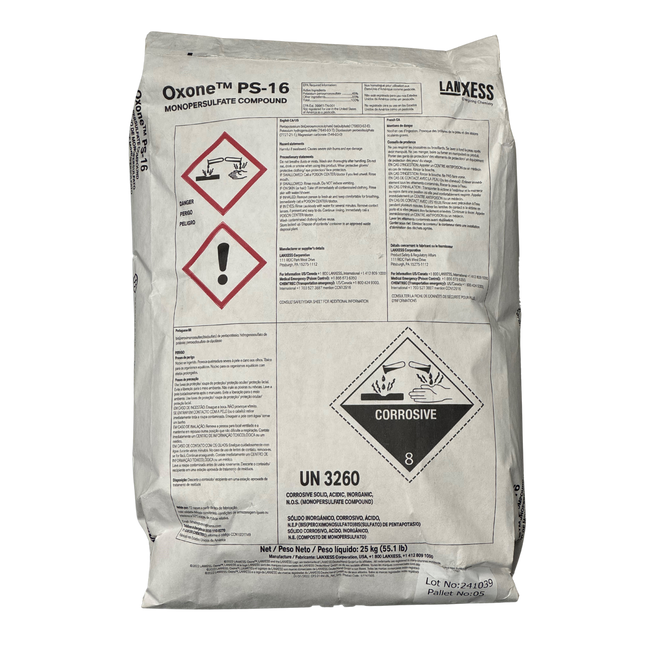
Oxone PS-16 Monopersulfate (Non-Chlorine Shock)
OxoneTM PS-16 Monopersulfate | Non-Chlorine Shock Oxone PS-16 Compound is used as an active ingredient in disinfectant formulations (not registered as a biocide in USA), and as an oxidizing agent in other formulations, such as pool & spa non-chlorine shock oxidizers, denture cleansers and laundry bleaches. The grade is also used as a wet strength resin paper repulping aid, metal surface treatment agent, selective oxidizer in chemical synthesis, wool shrink-proofing treatment, waste water treatment and odor control agent. Applications: Water Treatment: It can be used to treat water, including drinking water and pool & spa water, due to its ability to kill bacteria and neutralize contaminants. Cleaning and Sanitization: It's used in various industrial cleaning products, especially for disinfecting surfaces or purifying air and water. Oxidation Reactions: In chemical processes, Oxone PS-16 can be used as a strong oxidizing agent to break down pollutants or aid in chemical synthesis. Active Ingredients: Potassium Peroxymonosulfate (KHSO₅) - 45% Other Ingredients - 55% Total -100% Bag Dimensions: 21"x14"x4" (55.1lbs) Chemical Formula: KHSO₅·KHSO₄·K₂SO₄ Molecular Weight: 614.8 g/mol CAS Registry Number: 70693-62-8, 7646-93-7, 7727-21-1 Appearance White Granules Odor: Odorless Density 2.35 g/cm3 (68 °F / 20 °C) Boiling Point: None Solubility in water: Highly and Readily Soluble at 297–357 g/L at 22°C (72°F) GHS Pictograms: GHS Signal Word: Danger GHS Hazard Statements: H302, H314 GHS Precautionary Statements P260, P264, P270, P280, P301 + P312 + P330, P301 + P330 + P331, P303 + P361 + P353, P304 + P340 + P310, P305 + P351 + P338 + P310, P363, P405, P501 UN Identification Number: 3260 Proper Shipping Name: Corrosive solid, acidic, inorganic, n.o.s. (Monopersulfate Compound) Transport Hazard Class: 8 Packing Group: II DOT Placard: Oxone PS-16 Monopersulfate (SDS) Oxone PS-16 Monopersulfate Certificate of Analysis (COA)
$8.00 - $276.00
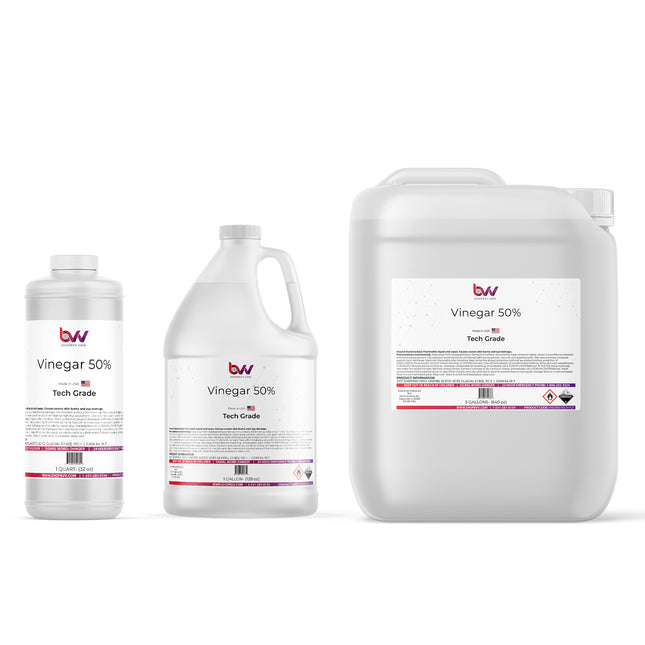
Vinegar 50% Technical Grade Industrial Stregnth
Technical Grade Vinegar 50% Made in USA - Industrial Strength *The strength of this vinegar requires Hazmat Shipping Fees* The acidic nature of nontoxic vinegar is so powerful it dissolves mineral deposits, dirt, grease, grime from glass, tile, laminate, and stainless-steel surfaces. It deodorizes, and degreases surfaces in kitchens, laundry rooms, and bathrooms. This lab grade product delivers greater cleaning and descaling performance for industrial applications. Higher concentrations of acetic acid (Vinegar) like this can impair the cell membrane of bacteria and fungi, making this a great choice for disinfection. ***Recommended dilution varies by application. Chemical Formula: CH3COOH Molecular Weight: 60.05 g/mol CAS Registry Number: 64-19-7 Appearance Colorless Odor: Vinegar Density 1.061 - 1.075 g/cm3 Boiling Point: 100 °C (212 °F) Solubility in water: Completely Soluble GHS Pictograms: GHS Signal Word: Danger GHS Hazard Statements: H314 GHS Precautionary Statements P210, P233, P240, P241, P242, P243, P260, P264, P280, P301+P330+P331, P302+P361+P354, P303+P361+P353, P304+P340, P305+P354+P338, P316, P321, P363, P370+P378, P403+P235, P405, and P501 UN Identification Number: 2970 Proper Shipping Name: Acetic Acid Solution Transport Hazard Class: 8 Packing Group: II DOT Placard: Vinegar 50% Certificate of Analysis (COA) Vinegar 50% Safety Data Sheet (SDS)
$13.00 - $2,650.00

Citric Acid 97% USA - High Purity - Anhydrous FCC, USP, Kosher
Citric Acid 97% Kosher | USP/GMP/FCC Food Grade | Anhydrous | USA Made (in Iowa) Our citric acid is granular, and has the look and feel like granular sugar that were all familiar with. The citric acid is a translucent white crystals and is a tart acidic taste. Its slightly hydroscopic and melts at 307°F. The citric acid is manufactured using a submerged fermentation process from a glucose and /or sucrose carbohydrate substrate. It's produced in accordance with good manufacturing practice and is considered "GRAS" Generally Recognized As Safe by the Food and Drug Administration (FDA). Chemical Formula: C6H8O7 Molecular Weight: 192.13 CAS Registry Number: 77-92-9 Appearance Solid White Granules Odor: Odorless Density 1.66 g/cm³ Boiling Point: None Solubility in water: Completely Soluble GHS Pictograms: GHS Signal Word: Warning GHS Hazard Statements: H319, H335 GHS Precautionary Statements P261, P264+P265, P271, P280, P304+P340, P305+P351+P338, P319, P337+P317, P403+P233, P405, and P501 UN Identification Number: None Proper Shipping Name: None Transport Hazard Class: None Packing Group: None DOT Placard: None Cargill Technical Data Sheet Citric Acid Anhydrous 99.7% Food Grade Certificate of Analysis (COA) Citric Acid Anhydrous 99.7% Food Grade Safety Data Sheet (SDS)
$12.00 - $120.00







